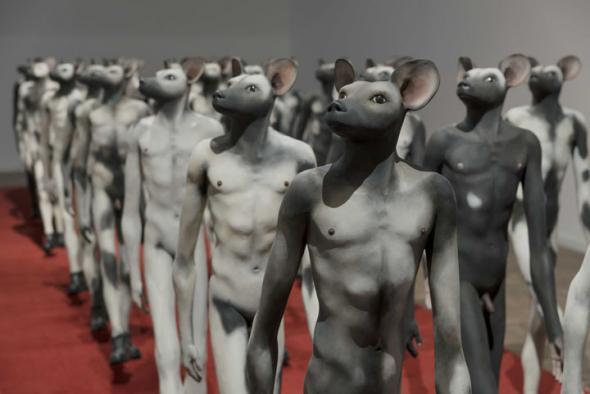The Fallacy of “Reverse Racism”
The Attention. Attention: Healthy, robust forty-something-year-old black girl to sell. Really good cleaning and cooking skills. Cheap price due to the urgent need, in the following address: alley Largo 2. The same owner is also selling a real tortoise.
The Protest. Vehement protest against anyone who has provided or will provide a hiding place to the undersigned’s slave who has been a fugitive since February 7th this year. The fugitive escaped from her owner in the Queimado parish and took a roughly one-year-old, similar looking dark-skinned daughter. Father Duarte.
The Escape. Run-away slave. He has been on the run since March 3rd last year. Roughly 61 years old Congolese man called Joaquim, dark toned skin, white beard and hair, big eyes and good teeth, rather short; has a mutilated right hand’s thumb.
 Infantry with Beast, Jane Alexander, 2008
Infantry with Beast, Jane Alexander, 2008
These excerpts from the Memorial of Slavery and Slave Trade in Cacheu – an important Slavery trading hub in Guinea-Bissau – illustrate how the racial relations, derived from colonialism and Slavery, scaled-up from “the negative difference to the objectification of the African”(I. Castro Henriques) – compared, treated and tagged as a domestic animal, a woorjing and service animal, stripped from any dignity, targeted to violent subdue, and, with the slave trade, subjected dehumanization rarely impaired in the History of the world. The average lifespan for a enslaved person was roughly ten years as António Carreira pointed out in Notas sobre o Tráfico Português de Escravos, in 1978.
The Trans-Atlantic slave trade became legal and a tax levied was implemented as any other transaction. The Catholic Church supported - both morally and religiously - the slavery project whose intends were mainly commercial and political. Later, the Industrial Revolution – whose motor was the production of cotton (Sven Beckert), an economy sustained by enslaved people in the Americas, as Noam Chomsky acknowledged – would put an end to legal slave trade, but not of Slavery, which continued to fuel both the Industrialization process and the development progress of the West. Marcus Rediker showed the centrality of Slavery and enforced labour to the rise of capitalism, stressing “the importance that galley-ships had in the production of race categories”. It is from within this context that racism arises - a historical oppression, a systematic violence, a power relation established over deep inequality. And that is why racism is intrinsically and historically connected with the undermining subjugation of Black people (not of White people).
Faced with this scenario, to believe in “reverse racism”, or in the racism of the oppressed against the oppressors, as the comedian Aamer Rahman ironically joked, would require us to get in a time machine that could rewind History and change the respective positions of power. But we can’t reverse History, even with the several attempts to naturalize it, to deny it and to manipulate it. Hence the importance of paying attention to the reluctant times we are now living in, which repeatedly insist on following the same old paradigms and refuse to make structural changes.
To validate “reverse racism” is to enable the boycott of the anti-racist movement and to silence the Black subaltern voices that legitimately rise. It is to reduce racism to a question of “human nature” transversal to all human behaviour, therefore natural. Under that equation, we can all be racists to one another, forgetting that in this “all” there are those who oppress and those who are oppressed; those with power and those “unempowered” who struggle to be visible within their own societies; and there are those who to this day are the beneficiaries of the legacy of Slavery and those who, on the contrary, carry that burden that translates into racial segregation, poverty, and social exclusion.
p.p1 {margin: 0.0px 0.0px 0.0px 0.0px; font: 12.0px Garamond; color: #000000; -webkit-text-stroke: #000000; min-height: 13.0px} p.p2 {margin: 0.0px 0.0px 0.0px 0.0px; font: 12.0px Garamond; color: #000000; -webkit-text-stroke: #000000} span.s1 {font-kerning: none}
The Attention. The Afro-descendent associations define “reverse racism” as an “attempt to legitimate the continuous control exercised upon the people that suffered centuries of oppression, a mechanism that acts out of fear of an eventual retaliation” (AFROLIS); “a construction produced by the ones who intend to escape the real problem: structural racism”(DJASS); “a way to mask the perverse and silent racism under which we live” (FEMAFRO); “a reaction that illustrates the wish to preserve the racist structure that benefits them” (PLATAFORMA GUETO). In sum, “reverse racism doesn’t exist; what does exist is a form of self-defence by the ones who suffer racial discrimination” (SOS RACISMO).
The Protest. Racism implies a collective expression determined by History, power, and the epistemicide of Africa and Africans. So when racism is perpetuated by one single individual, this happens accordingly to a historical context that sustains and marks out his/her behaviour. A black-toned person might discriminate and prejudice against a white-toned person, but he/she cannot be racist, because the latter has not been the victim of (historical, political, economic and social) structures that would otherwise oppress him/her accordingly to his (white) phenotype.
The Escape. To those who believe in the fallacy of “reverse racism” or in the subtlety of racism in Portugal, I dare them to follow the exercise Jane Elliot made at a conference in the United States: those who would like to be treated like people of colour are in this country, please stand up!
Article originally published in Público, 13/7/2018.